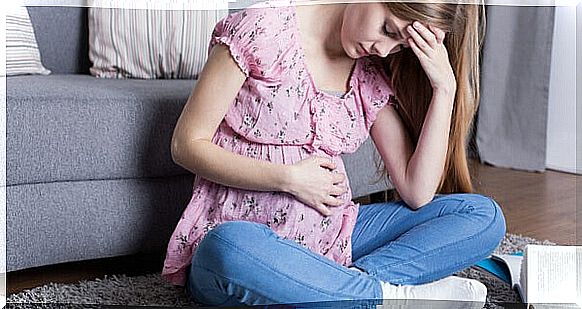Pregoressia: Pregnant Women’s Fear Of Gaining Weight

When a woman is pregnant, it is normal for her to gain between 9 and 14 pounds. Although this figure varies from case to case, usually after the first trimester, the mother gains a pound and a half a month. However, some pregnant women develop pregorexia, a disorder known as pregnant women’s anorexia and which breaks this rule.
They don’t gain weight or even lose weight, and they don’t get essential nutrients. All this prevents the fetus from growing well. Therefore, and although this happens in a limited number of cases, the repercussions of pregorexia can become very serious for both the mother and the fetus.
How do they go about avoiding gaining weight?
This Anglicism derives from the fusion of the words “pregnancy” and “anorexia”. It is an eating disorder that affects pregnant women who develop an irrational fear of gaining weight during the gestation period. They want to keep their body weight to such an extent that they do everything they can.
They choose to limit what they eat as much as possible by following low-calorie and very restrictive diets. They avoid foods with a lot of carbohydrates and fats and deprive themselves of any “whims” typical of their condition. They engage in excessive and obsessive physical activity. They perform purgative techniques after large binges, such as vomiting or laxatives. Very dangerous!

Pregoressia: Does it only concern women who have suffered from anorexia?
The mother can develop pregorexia without having previously presented any eating disorder. But that’s usually not the case. Most of the time she has previously suffered from some eating disorder such as anorexia or bulimia nervosa. However, a history of this type, although it increases the risk, does not guarantee in any case of developing pregorexia during gestation.
The causes of this disorder are rooted in psychological, biological and interpersonal factors that predispose women to develop an eating disorder.
Symptoms of pregorexia
The main indications that the woman suffers from this disorder are to avoid talking about her pregnancy, denying her problem and rejecting her physical state and the changes that characterize it. All of this is the result of his feeling of fear and anxiety of gaining weight. Basically, he is convinced that if I don’t talk about it, this state doesn’t exist.
Physically, the factor that draws the most attention is that, during pregnancy, these women gain very little weight or even lose weight. It is most noticeable in the second trimester, when the body changes should be most noticeable.
Eating a low calorie diet, exercising excessively, and purging can cause nausea or headaches and excessive fatigue. They also cause difficulty concentrating and sleep disturbances. All of these symptoms not only jeopardize pregnancy, they can also cause problems during delivery and the subsequent development of the baby.
Consequences of pregorexia for the mother
On the one hand, the consequences of this disease are those resulting from the lack of food intake. These include malnutrition, anemia, bradycardia, arrhythmias, hypertension, hair loss or very dry and cracked skin. To all these consequences, which are already serious in themselves, must be added the implications for pregnancy.
The decrease in essential minerals, as a result of inadequate intake, can cause bone decalcification, as well as a consequent low milk production. This will clearly make it difficult, once the baby is born, for breastfeeding to be adequate and satisfactory.
Furthermore, these women may have less amniotic fluid, the fluid of vital importance for the fetus, which surrounds it and protects it from external shocks and possible injuries. And placental abruption can also occur. This condition can become very serious, especially if it occurs in the third trimester.

How does it affect the fetus?
The mother’s nutrition is crucial for the development of the fetus. Therefore the consequences of this ailment are very dangerous. Pregorexia increases the chances of complications occurring during childbirth. Among them, for example: respiratory failure, low birth weight or very low values in the Apgar index. It can also cause premature birth (before 37 weeks of pregnancy), malformations in the fetus, neurological disorders, ADHD, or mental retardation.
In the event that the mother has had severe placental detachment, the baby will surely have growth problems. Pregorexia also increases the chances of a baby dying during the first month of life, as does the birth of a stillborn baby.
Complete treatment
Nutrition during pregnancy is as important as it always is. Not ingesting larger quantities of food means increasing the quality of the same. The mother, therefore, should pay attention to her diet, but not obsess about it. The earlier pregorexia is identified, the better. The consequences will be more likely not to cause irreversible harm to the woman and baby.
Since it is a psychiatric disease, in order to carry out an adequate treatment, the presence of a multidisciplinary and specialized team is necessary. Psychiatrist, obstetrician psychologist, dietician and nurse can help provide a complex and comprehensive approach to the case.
It is desirable to create a relaxed and relaxed atmosphere during meals, which must be done at regular times. The family is advised not to force or put pressure on the amount of food the patient should eat. It can be very counterproductive.
Both obesity and extreme thinness lead to an unsafe pregnancy. The best thing is that the diet during this period is balanced and varied. It is also advisable to do regular physical activity, especially yoga, pilates or walking. Aesthetics should never take priority if health is at stake. Even less so when it comes to a child’s health!









